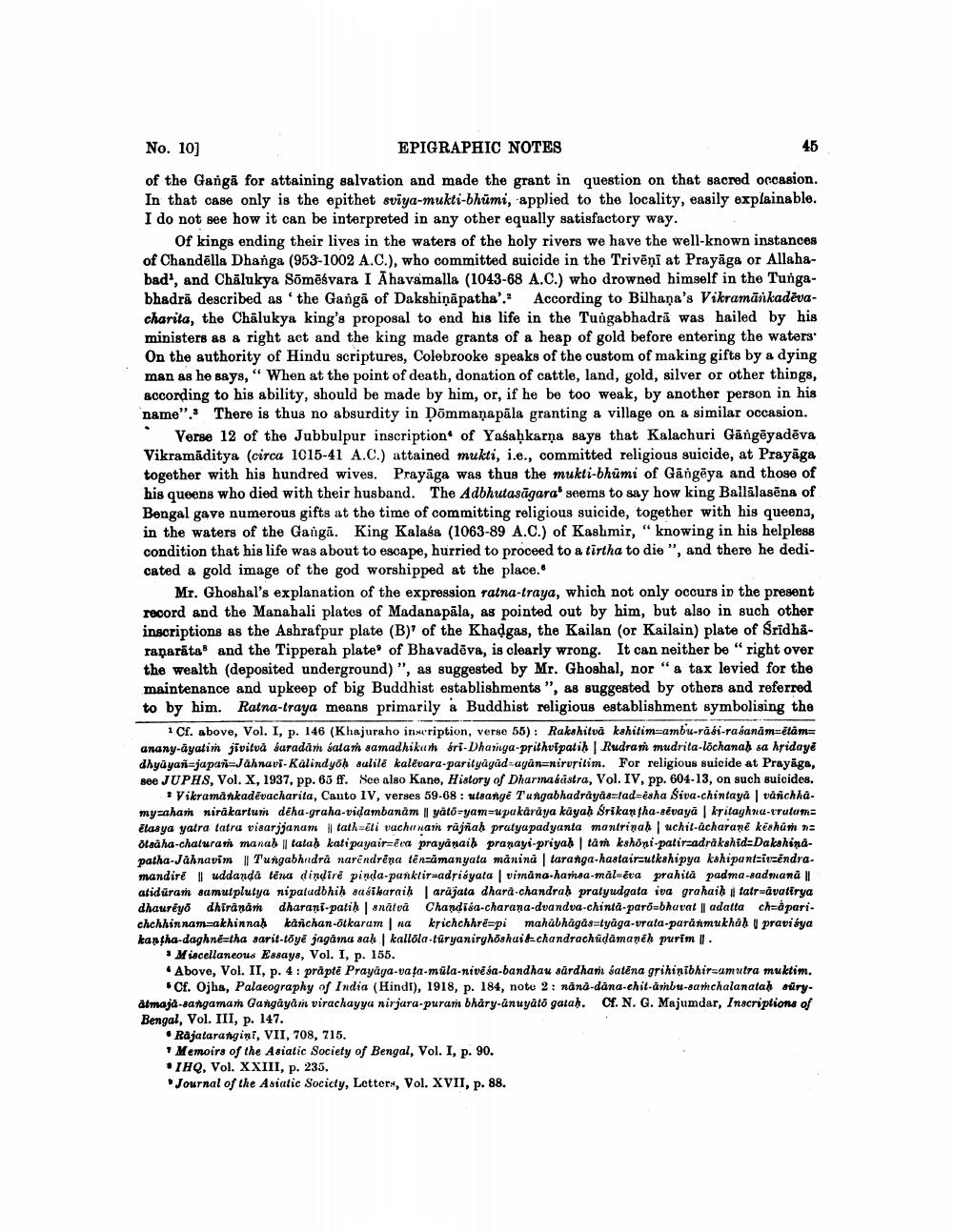________________
No. 10]
EPIGRAPHIC NOTES
45
of the Gangā for attaining salvation and made the grant in question on that sacred occasion. In that case only is the epithet sviya-mukti-bhūmi, applied to the locality, easily explainable. I do not see how it can be interpreted in any other equally satisfactory way.
Of kings ending their lives in the waters of the holy rivers we have the well-known instances of Chandēlla Dhanga (953-1002 A.C.), who committed suicide in the Trivēņi at Prayāga or Allahabad', and Chālukya Sõmēsvara I Āhavamalla (1043-68 A.C.) who drowned himself in the Tungabhadrā described as the Gangā of Dakshiņāpatha'.: According to Bilhana's Vikramārkadēvacharita, the Chalukya king's proposal to end his life in the Tungabhadrã was hailed by his ministers as a right act and the king made grants of a heap of gold before entering the waters On the authority of Hindu scriptures, Colebrooke speaks of the custom of making gifts by a dying man as he says, " When at the point of death, donation of cattle, land, gold, silver or other things, according to his ability, should be made by him, or, if he be too weak, by another person in his name": There is thus no absurdity in Dommaņapāla granting a village on a similar occasion.
Verse 12 of the Jubbulpur inscription of Yaśaḥkarna says that Kalachuri Gārgēgadēva Vikramaditya (circa 1015-41 A.C.) attained mukti, i.e., committed religious suicide, at Prayāga together with his hundred wives. Prayāga was thus the mukti-bhumi of Gängēya and those of his queens who died with their husband. The Adbhutasāgara' seems to say how king Ballālasēns of Bengal gave numerous gifts at the time of committing religious suicide, together with his queens, in the waters of the Ganga. King Kalasa (1063-89 A.C.) of Kashmir, “knowing in his helpless condition that his life was about to escape, hurried to proceed to a tirtha to die ", and there he dedicated a gold image of the god worshipped at the place.
Mr. Ghoshal's explanation of the expression ratna-traya, which not only occurs in the present record and the Manahali platos of Madanapāla, as pointed out by him, but also in such other inscriptions as the Ashrafpur plate (B)' of the Khadgas, the Kailan (or Kailain) plate of Sridhåraparāta and the Tipperah plate of Bhavadēva, is clearly wrong. It can neither be "right over the wealth (deposited underground)", as suggested by Mr. Ghoshal, nor "a tax levied for the maintenance and upkeep of big Buddhist establishments ", as suggested by others and referred to by him. Ratna-traya means primarily a Buddhist religious establishment symbolising the
1 Cf. above, Vol. I, p. 146 (Khajuraho inseription, verse 55): Rakshitva kahitim-ambu-räsi-rašanām=ētām= anany-ayatim jivitvå buradan satan samadhikar éri-Dharga-prithvipatih Pudran mudrita-lochanah sa hridayê dhyayari-japan-Jahnavi-Kalindyoh sulile kalêvara-parityāgūd-uyan=niruritim. For religious suicide at Prayāga, gee JUPHS, Vol. X, 1937, pp. 65 ff. See also Kane, History of Dharmasastra, Vol. IV, pp. 604-13, on such suicides.
* Vikramankadēvacharita, Canto IV, verses 59-68: utsange Tungabhadrayasutadesha Siva-chintaya | vafichha. my=ahan niräkartun dēha-graha-vidambanam Il yâto=yam=upakarāya kuyah Srikantha-8ēvayā kritaghnu-trutuma Elasya yatra tatra visarjjanum | tath=ēti vuchar nai rajñaḥ prutyapadyanta mantrinah uchil-acharané késhum na Otaåha-chaluran manah | tatah kalipayair=ēva prayanaih pranayi-priyah tam kshöni-patir-adrakshid=Dakshinapatha-Jahnavim || Tungabhadrā narēndrēna tēnsamanyata manina | taranga-hastair=utkshipya kshipantsivaēndra. mandire l uddanda tena dindiré pinda-panklir=adsióyata | vimana-hamsa-mal-éva prahită padma-sadmana | atiduram samutplutya nipatadbhih sabilaraih arajata dhara-chandrab pratyudgata iva grahaih tatr-avatirya dhaurēyo dhiranan dharani-patih | Snātva Chandisa-charana-dvandva-chinta-parõ=bharat || adatta ch=parichchhinnam-akhinnah kañchan-otkaram na krichchhre=pi mahabhagås=tyäga-vrata-paranmukhah i pravi ya kantha-daghnéatha sarit-toyē jagama sah kallola-túryaniryhoshuikchandrachūdāmanéh purim l.
: Miscellaneous Essays, Vol. I, p. 155.
Above, Vol. II, p. 4: prăptē Prayaga-va ța-mula-nivēša-bandhau sārdhan satēna grihinibhir=umutra muktim.
Cf. Ojha, Palaeography of India (Hindi), 1918, p. 184, note 2: nana-dana-chit-anlu-surchalanatah suryåtmaja-sangamam Gangayām virachayya nirjara-puram bhary-anuyato gatah. Cf. N. G. Majumdar, Inscriptions of Bengal, Vol. III, p. 147.
• Rajatarangini, VII, 708, 715. Memoirs of the Asiatic Society of Bengal, Vol. I, p. 90. IHQ, Vol. XXIII, p. 235. Journal of the Asiatic Sociсty, Letters, Vol. XVII, p. 88.




